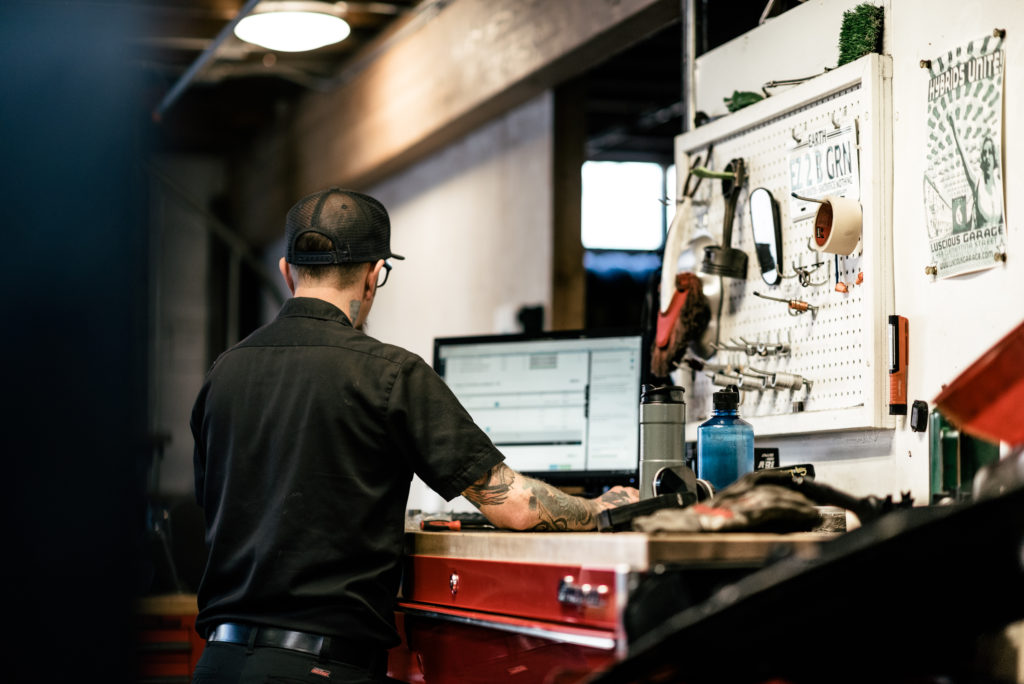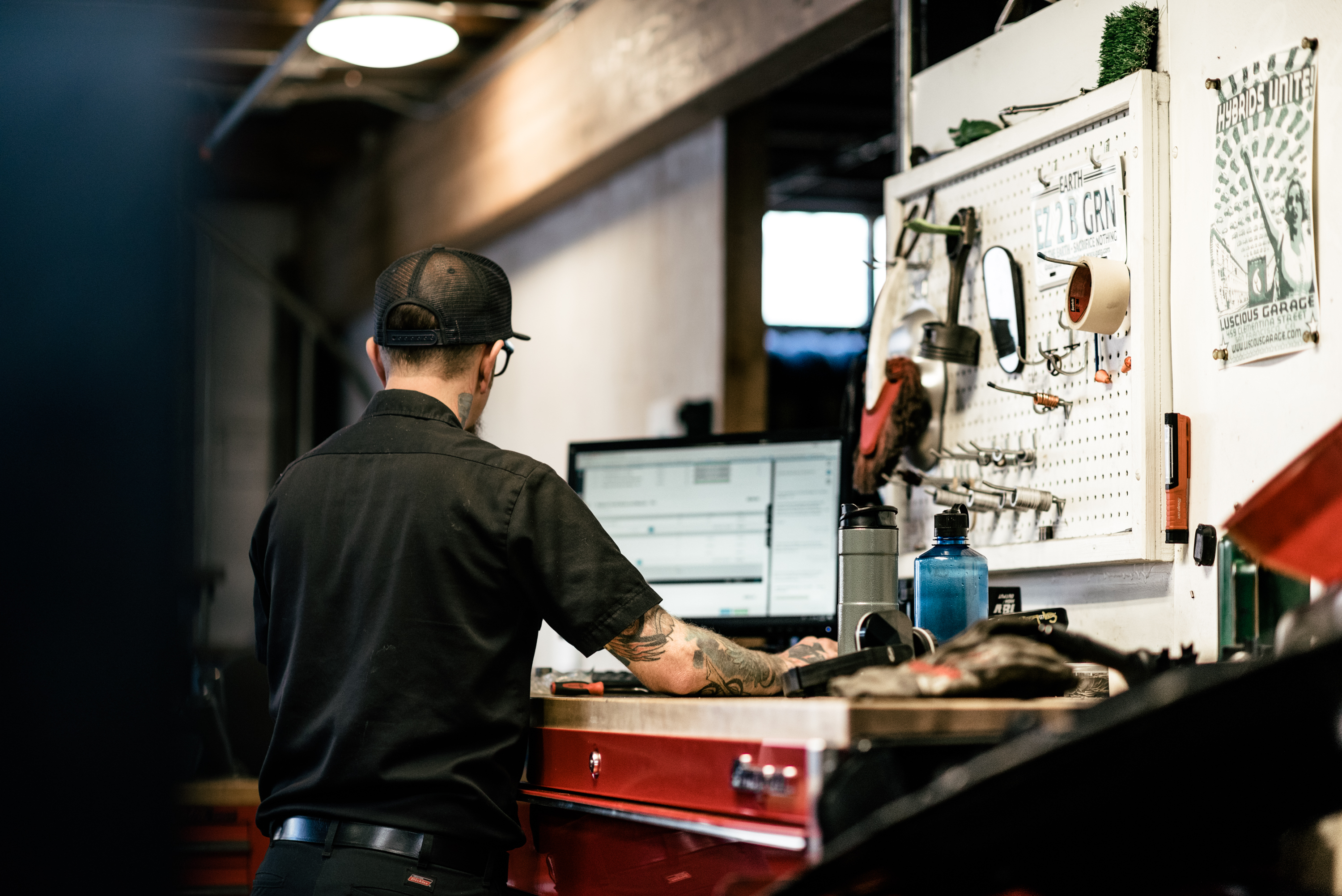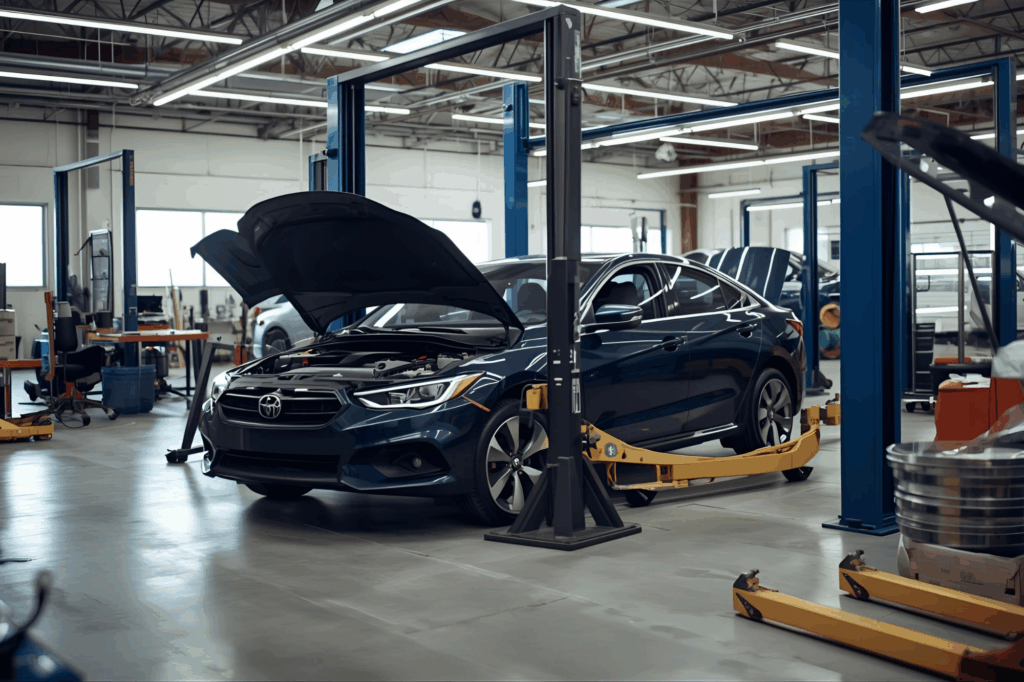
Connected cars will bring many changes
As increasing numbers of new vehicles come with built-in connectivity and wi-fi hotspots, vehicle manufacturers will have 24/7 access to their vehicles. The carmakers will know where their vehicles are, how well they are running, and whether they need to be serviced or repaired. How will this affect your shop and its operations?
Vehicles use a huge amount of software to run their systems, and that software needs updating from time to time. As Tesla has demonstrated, connected cars can receive over-the-air software updates at any time of the day or night. These updates have been used to upgrade performance, add features, and fix previously-identified problems. Other manufacturers are following Tesla’s lead and are introducing new models with these capabilities. Eventually, all automotive software will be updated this way.
That’s just one aspect of what connected cars are capable of. Here are some others:
- Cars will monitor their own operating status and send actionable information back to the manufacturers. This can trigger a message to the owner to bring the car to a dealer for service or repairs.
- Remote diagnosis will become possible, even allowing for the dispatch of a mobile repair vehicle to fix the specific problem at the owner’s home or workplace.
- Artificial intelligence can observe and predict when a component will wear out or fail, allowing for advance notification and parts ordering.
- Air quality authorities could decide to monitor the emission control systems of connected cars, issuing repair alerts when a trouble code is detected, and even potentially issuing tickets if repairs are not made in a timely manner.
- As we approach the future world of autonomous vehicles, communication with the road infrastructure will be possible, alerting drivers to traffic density, bad weather, any accidents ahead, how long until upcoming traffic lights change, and other useful information.
- E-commerce will be integrated into infotainment systems as manufacturers seek to monetize the data being created in each connected vehicle, providing marketing and sales opportunities to many types of businesses. You will receive offers from nearby restaurants, motels, and fuel stations, as well as from retail and online companies of all kinds, based on your personal preferences.
Repair shops will need to adapt to connected cars
As the connected cars of today and tomorrow add more and more electronic content, these vehicles will demand the expertise of technicians who know their way around complex computer technology. Sophisticated processors will analyze the data provided by sensors throughout the vehicle, making decisions on how the car should react to specific road conditions and hazards. Thoroughly understanding these systems and how best to fix them will become more and more important, as the number of vehicles containing them steadily increases.
The technicians working on these systems will need to possess a blend of cutting-edge high-tech knowledge and high levels of competence in dealing with the mechanical pieces that the electronics interface with. Regular ongoing training will be necessary, to keep these techs at the top of their game, able to understand and repair all of the latest vehicles coming off the assembly lines.
As mentioned above, the major unknown continues to be the question of independent shops’ access to the trove of information needed to work on the connected cars of the near future. While any shop can currently access a car’s “brain” through its OBD port, this can only be done while the vehicle is in the shop. Connected cars, on the other hand, can send any relevant abnormal operating data directly to the manufacturer, the moment it occurs. Where do you think the manufacturer will send the car owner for a repair when this happens? The manufacturer’s local new car dealer, or your shop? Think about it!
Data is shaping up as the next battlefield in the ongoing dealer/independent shop conflict. Manufacturers see their cars’ operating systems as their own intellectual property, and they will zealously guard it against any outside “intrusions.” Industry organizations are currently working on a practical and secure way for aftermarket repair shops to have access to this crucial information. Whether the individual manufacturers become the gatekeepers, or a central data repository is established, shops will need access to the data in connected cars. Without the ability to identify these vehicles’ problem areas and make repairs efficiently, it could be game over.
Will the manufacturers retain control of this data forever, provide access when a car’s warranty expires, or will they make it available from day one? A final answer that resolves this issue may end up coming from a judge in a courtroom. Stay tuned!
The effects of advanced driver assistance systems (ADAS)
It was not so long ago that rear-view cameras were a rare sight on new vehicles. Today, they are mandated by law to be on every new car sold in the US. As technology moves forward, there has been a host of new advanced driver assistance systems (ADAS) introduced within the past few years on new vehicles. It is not uncommon to see these safety systems as standard equipment on entry-level vehicles from a variety of manufacturers. As the numbers of these vehicles on American roads increase, independent repair shops should prepare themselves to deal with the unique challenges that servicing ADAS presents.
Another level of technology built into today’s vehicles
ADAS represent a whole new family of automotive computer-controlled mechanical systems. They include:
- Automatic emergency braking (for other vehicles and pedestrians)
- Adaptive cruise control
- Lane departure warning
- Blind spot monitoring
- Rear cross-traffic alert
- 360-degree around-view cameras
- Automatic high beams
- Traffic sign recognition
- Night vision
- Adaptive headlights (follow steering around curves and turns)
- Self-parking
Some of these systems use specific sensors, cameras, and radars (depending on the feature) to process and provide information that can alert the driver to safety-related issues as they crop up. Others are even more sophisticated, actually taking control of the vehicle’s brakes or steering to prevent a potential accident before it happens.
ADAS systems must be calibrated to work properly
The ADAS sensors that oversee the operation of each system must always be in proper alignment. These sensors are complex pieces of technology that possess their own microprocessors and computer software. Unfortunately, due to the locations of many sensors in the bumper and grille areas, it is easy for these critical pieces of equipment to get hit and become misaligned. An accident or fender-bender is an obvious cause, but even minor jobs like wheel alignment or repairs to the suspension can affect the sensors.
Another critical area is the windshield, where ADAS cameras are often mounted. Replacing the windshield often mandates an OEM windshield only, and the cameras on it must be properly mounted and correctly aligned. Sensors that are out of alignment can also produce trouble codes in the car’s computer memory, illuminate warning lights, and even cause steering problems.
Grab this opportunity for a stream of additional business
What will happen when one of these ADAS-equipped vehicles drives in for a repair of one or more of these systems? Are you prepared to deal with the complexities of ADAS? Will you take steps now to train your staff to work on and calibrate these systems, or will you be sending all of this work (and who knows how much other repair work) to the new car dealer?
Yes, it will require some investment in equipment and training, but can you afford to pass on the potential benefits of this growth area? These sophisticated and in-demand features are already on many high-volume vehicle lines being produced by Honda, Toyota, and other mass-market brands, as well as most luxury brands. Vehicles with ADAS will need to have their systems checked and calibrated periodically, to assure the safety of the driver and the occupants. Sure, it is a little bit of rocket science, but if dealers can handle it, you should have no problems!
The never-ending drive for fuel efficiency
The past few years have brought some major changes under the hoods of the cars that travel the nation’s roads. The drive for ever-increasing fuel economy has resulted in significant changes to the drivetrains powering the latest vehicles in the fleet. These changes include:
- Smaller engines with turbochargers
- 48-Volt mild hybrid systems
- Plug-in hybrids with limited all-electric range
- Thinner viscosity oils
- Active grille shutters
- All-wheel drive systems that disengage when not needed
- Cylinder deactivation
- Start-stop systems
- Continuously variable transmissions
- Dual-clutch transmissions
- Electric power steering
- Regenerative braking systems
Manufacturers have clearly stated that it will soon no longer be possible to meet fuel economy and emissions standards with a purely internal combustion powertrain. Shops across the country (not just in California) will need to be prepared for the electrified systems that will increasingly be a part of the gasoline engines powering your customers’ vehicles.
As 48-volt mild hybrid systems become more common, eventually becoming standard equipment, there will be no longer be a distinction between a hybrid and non-hybrid vehicle. Start-stop systems will also be integrated, saving fuel whenever the vehicle comes to a halt. Regenerative braking systems will return power to the high-voltage batteries that power the starter-generators in these systems.
And then there are plug-in hybrids. These have enough battery power to go up to 50 miles on electric power only, with a gasoline engine to take over when the battery is depleted. If US cities follow the environmental trends taking form in Europe, only vehicles that can run on electric power may be allowed into the city centers.
Are you ready to diagnose and repair the problems that your customers who own these vehicles will bring to you? It’s time to prepare because the future is now!
Self-driving cars will be driving themselves to your shop – eventually
There’s a tremendous amount of fanfare about autonomous (self-driving) cars in our future. The promise of eliminating human error from the driving process could reduce accident fatalities to near zero. No drunk driving, no distracted driving, no road rage, no radar traps, no speeding tickets. Sounds wonderful, doesn’t it?
The technology to achieve autonomy is steadily developing, funded and researched by both giant tech companies and traditional auto manufacturers. While there’s plenty going on to keep our news feeds on this topic full, it will be a long time before self-driving cars will be part of our daily lives.
For one thing, there is absolutely no regulatory framework yet in place. The government has allowed testing of autonomous vehicles (AVs) on public roads, but it will be years until AVs are perfected, can be purchased at reasonable prices, and used as personal vehicles.
Then there is the infrastructure issue. To operate at the highest levels of safety and proficiency, AVs will need to know what is going on far down the road in every direction. There will need to be information on road and traffic conditions, constantly being transmitted at high speed by traffic lights, cameras, first responders, and other vehicles. This will allow AVs to avoid slow traffic and accidents before they can be seen. It will be a brave new world, whenever it comes to pass.
How can you prepare to work on AVs if there are none on the road? By becoming proficient in repairing the various ADAS features discussed above! These systems are the building blocks of the next generation of autonomous vehicles. The sensors will be more sophisticated and the computer processors will be more advanced, but the principles will remain the same. All of the ADAS features, plus some others, will be integrated into one main system, controlled by a connected computer “brain.” This is another future revenue stream that you should be ready to capitalize on.
Electric vehicles are coming, but the exact timing is not certain
Electric vehicles (EVs) are out there, but at the moment, they are not evenly distributed around the country. If you happen to be in California, EVs are quite common, spearheaded by large numbers of Tesla vehicles. But as you leave the major metropolitan coastal areas, EVs are very thin on the ground, for a variety of good reasons which still remain largely unresolved:
EVs are expensive: The high cost of lithium-ion battery packs makes EVs unaffordable to the average buyer. Most consumers are unwilling to spend a premium of $10,000 or more for an EV, compared to the equivalent gasoline-powered vehicle. EVs are predicted to reach price parity with internal combustion engine vehicles by 2030, so this obstacle will eventually go away.
EV charging infrastructure is inadequate: Most EV owners will have difficulty planning their charging needs on a trip. This is thanks to the patchwork of different charging systems scattered around the country. Many of these systems require signing up in advance to set up an account. EV drivers have often found that a given charging station is not operational or is locked behind a fence when they arrive to charge. This can be a very stressful experience when your battery is low!
Until charging stations are as common and easy to use as gas stations, this concern will persist. The only current exception to this limitation is Tesla owners, who can use the company’s nationwide Supercharger network to drive long distances without fear.
EVs need a home charger: EV owners like to brag about “leaving home with a full tank every day.” But to do this, high-voltage chargers must be installed at their residences. Homeowners can do this, but it is an extra expense on top of the electric vehicle.
And what if you don’t own a home? Most apartment and condo dwellers will not have access to home charging, especially in cities. The fast-charging solid-state batteries of the future may solve this problem.
EV technology is already out there
Even though EVs are only about two percent of current new car sales, the latest generation of EVs has been on sale since 2010. The Nissan Leaf has been available since 2010 and has sold over 400,000 units worldwide. The Tesla Model S had its debut in 2012 and has sold more than 250,000 units since. This shows that there are definitely EVs out there that are past their warranties. Many of their owners could certainly benefit from the services of an independent shop with techs who understand these vehicles.
And let’s remember that much of the technology within these EVs is also found in many gasoline-electric hybrid vehicles. Conventional hybrids, plug-in hybrids, and 48-volt mild hybrids incorporate electric vehicles’ high-voltage batteries, electric motors, and control units.
You can get a head start on the eventual popularity of EVs by training your staff and welcoming all types of hybrid vehicles, as well as older EVs. Getting the word out about this specialty could attract customers from large distances. Even better, many of your current hybrid-owning customers are likely to buy an EV next, and you will be ready!
EVs will still need servicing and repairs
It’s true that EVs have fewer moving parts than gasoline-engine cars. But that doesn’t mean that EVs don’t need service! These vehicles won’t need oil changes, but they will wear out their tires, shocks and suspension parts. They will need brakes eventually, even with regenerative braking. They will come in with electrical problems of all types. Their interiors will suffer from all the traditional issues that can occur inside any vehicle, like seat and window motor failures, climate control issues, faulty switches, or dash display screen problems. Software skills will also be required to diagnose many EV issues.
These vehicles will also come with sophisticated ADAS features and they may even drive themselves at some point! Many EVs will have the connectivity and processing power to diagnose themselves and contact a repair shop to make a service appointment. Will your shop be on these vehicles’ speed dialing systems? If you play your cards right, there will be plenty of work for an independent repair shop that knows its way around an EV!
Stay Tuned for part three of this series coming soon!
Author: Stephen Fogel



